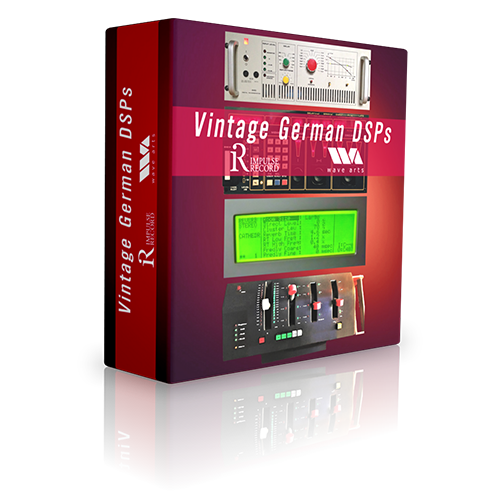
Your Price $59.95
You Save $20.00
Vintage German DSPs
Vintage German DSP Reverb – the 245, 246, 248 and 250. (7) Units – 242 Files – 340 megs
7 Different DSPs Contained in this bundle!
Sampled in Europe and the USA
Many pieces of gear listed have been used on major recording artists, albums and Grammy productions.
Full Listing of DSPs:
German 245 – (47 files) New York and Switzerland
German 246 – (35 files) Austria and Switzerland
German 248 – (122 files) Nashville, TN and Denver, CO
German 250 – (34 files) Nashville, TN
Physical DSP Overviews
These overviews are general and with EQing almost any DSP finds its use and purpose. Plate reverb in general, tends to be dense
and with the introduction of the DSPs, some would argue that they were easier to manipulate, with others suggesting that nothing
can or could replace the analogue reverb sound. Because many of today’s engineers are more accustomed, to dialing in reverb,
without much need for tweaking, beyond dry, wet signals and minimal EQing, there are numerous files that have been pre EQd to
sound like a given space, along with hybrid versions where early reflections (usually up to 100ms where your ears tell you,
“That’s a big bright space and I hear the instrument coming from stage left,” etc) have been employed, although much of the
spatial and early reflections was accomplished with the introduction of these early DSPs.
It’s interesting to note that while we have very high sampling rates today, back in the 1970s and 80s, A/D convertors had a lot
lower frequency response. In fact, many of the early units had a frequency response between 8k and 10k Hz. While some may
question that, others embrace it and often employ these units and impulse response files on specific recording applications.
These units are so popular, that they are still used on iconic pop artists and their recordings today!
What Files Are Included
With the DSPs, we captured the heart and essence of each piece of gear. This was a massive project with engineers and studios
literally from around the globe. Knowing the potential of the project, moving forward with studios who were well regarded,
achieving a great deal of success in the industry, recording some of the biggest names, was very important for a number of
reasons. Firstly, they know their gear, it’s behaviors and what works best. Secondly, the gear had been used on numerous
Grammy nominated and winning productions. Lastly, knowing that time was a commodity, studios and engineers were given specific
criteria in regards to how to best implement the library goals with a high standard of impulse response capture and could deliver
under that criteria.
Because time was critical, the “sweet” spots of each DSP was recorded. One could argue the difference in the files of a 2.5
second sample over a 2.75 second sample, but the reality, even for most award winning engineers, is that between software
adjustments alone, time could be conserved, while still achieving phenomenal results.
With that in mind, we hand picked some of the finest early German DSPs and there really is something for everyone in the mix.
This library will compete with anything out there!
Here are some DSP generalities and basic characteristics.
German 244 – Introduced around 1980, the 244 is fairly basic in functionality at least from an engineering point of view, with
limited functions of reverb times between 0.4s. -4.5s. in 16 selectable steps, two position switchable response curve switches,
for low and high frequency, with a frequency range response between 30hz and 8khz. The 244 was designed after the 250 as a
replacement with a smaller foot print, being rack mountable, with a smaller body weighing in at 44 lbs. While the vast majority
of early DSPs had a much narrower frequency range compared to today’s equipment and software, don’t underestimate the classic
sound and vintage characteristics of the 244.
German 245 – The 245 was the 244 with the addition of pre-delay and a reflections settings. While the other German units
incorporated some of these same reflection settings in algorithms, the 245 gave you the flexibility to really dial in those
settings. When you look at these files, under the microscope, it’s interesting to see the early reflections (spikes) in the
audio files. There was a great deal of audio engineering science that went into the reflections, how far or close together
they would be, to emulate different rooms, halls, etc. The 245’s longest reverb time is around 5 seconds.
German 246 – uses the algorithms from the 250 as does the 248, with a great deal of user control and flexibility.
It also encompasses a slot for expanded memory similar to the 248. It has 6 program modes with a programmable low pass filter,
reflections and decay.
German 248 – The 248 was the last unit made in this series and is treasured by many being solid and quite nice sounding.
The 248 was loaded with all kinds of presets and adjustable algorithms including, Baroque Church, Cathedral, Romanesque Church
with numerous size rooms, halls and even stairwells, bathrooms and a preset called “Tiny Room.” The 248 is a very able
processor and is used even today, like so many of these vintage units, by major recording artists around the world. O
German 250 – The first true DSP manufactured. The 250 uses 12-bit, 24k converters, low passed around 11Khz. This unit has
large levers on top, weighs around 100 lbs and looks like it is from outer space – nick named the “R2D2.” No doubt, this is
one of the finest DSPs from the era, with the few who own one of these remaining pieces of vintage outboard gear, still using
them frequently and unabashedly. There is a 251 and 252 unit that are off shoots of this model. There were only around 250 of
the original units made and then were adapted with the newer 251 interface and 252 upgrades with the 252 being a rack mounted
version.
